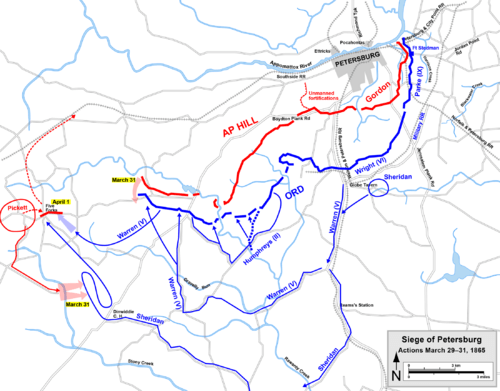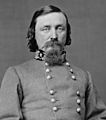Battle of Dinwiddie Court House facts for kids
Quick facts for kids Battle of Dinwiddie Court House |
|||||||
|---|---|---|---|---|---|---|---|
| Part of the American Civil War | |||||||
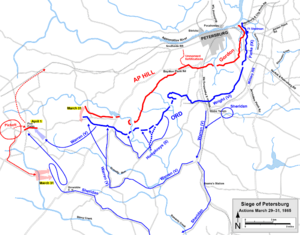 Map of the Siege of Petersburg of the American Civil War, actions March 29–31, 1865 |
|||||||
|
|||||||
| Belligerents | |||||||
| Commanders and leaders | |||||||
| Philip H. Sheridan | George E. Pickett Fitzhugh Lee |
||||||
| Strength | |||||||
| 9,000 | 10,600 | ||||||
| Casualties and losses | |||||||
| 354 | 760 | ||||||
The Battle of Dinwiddie Court House happened on March 31, 1865. It was a key fight during the last days of the American Civil War. This battle was part of the Richmond-Petersburg Campaign and the start of the Appomattox Campaign.
The battle involved the last big attack by General Robert E. Lee's Confederate forces. They tried to stop Lieutenant General Ulysses S. Grant's Union Army. Grant's goal was to cut off the Confederates' supply lines. He wanted to force them to leave their defenses around Petersburg and Richmond.
On March 29, 1865, a large Union cavalry force moved towards Dinwiddie Court House. This place was about 4 miles (6.4 km) west of the Confederate lines. It was also about 5 miles (8 km) south of an important road junction called Five Forks.
Major General Philip Sheridan led the Union cavalry. His force included about 9,000 to 12,000 troopers. They aimed to control Five Forks, which was vital for the Confederate supply line, the South Side Railroad.
Contents
Why the Battle Happened
The Long Siege of Petersburg
For 292 days, the Union Army had been trying to capture Petersburg and Richmond. This was a long fight in trenches. Union General Ulysses S. Grant wanted to wear down the smaller Confederate army. He also aimed to cut off their supplies.
After a battle in February 1865, the battle lines stretched even further. General Robert E. Lee had very few soldiers left to defend them. Lee knew he had to move his army soon. He hoped to get food and supplies and join another Confederate force in North Carolina.
Lee believed that if they could quickly defeat the Union army in North Carolina, they might return to fight Grant. But he also knew his army was getting weaker. It could not hold the defenses around Richmond and Petersburg much longer.
Confederate Attack on Fort Stedman
In March 1865, Lee approved a plan to attack Fort Stedman. This was a Union fort. The goal was to break the Union lines or force them to shorten their defenses. This would give Lee's army a chance to escape or join other Confederate forces.
The surprise attack on Fort Stedman happened on March 25, 1865. It failed badly. The Confederates lost about 4,000 soldiers. This was a huge loss for their already shrinking army. The Union Army did not lose much ground.
After this defeat, Lee knew Grant would soon attack his last supply lines. These were the South Side Railroad and the Boydton Plank Road. Cutting these would trap the Confederate army in Petersburg and Richmond.
Grant's Plan to Attack
Even before the Fort Stedman attack, Grant had planned his own offensive for March 29, 1865. He wanted to force the Confederates into an open battle. If they stayed in their defenses, he would cut their supply lines. This would stretch Lee's army to its breaking point.
Grant ordered different Union corps to move. Major General Philip Sheridan's cavalry was to move west. Their first job was to take control of Dinwiddie Court House. They also needed to cut the Boydton Plank Road there.
Lee's Response to the Threat
General Lee knew Grant was a threat. He moved soldiers to strengthen his right flank. He put Major General George Pickett in charge of a mobile force. Major General Fitzhugh Lee's cavalry would help Pickett. Their job was to protect Five Forks.
On March 29, Pickett's soldiers moved towards Five Forks. Bad weather and slow trains made their journey difficult. They finally reached their destination late at night.
Battle of Lewis's Farm
On March 29, Major General Gouverneur K. Warren's Union V Corps moved towards the Confederate lines. They fought a battle at Battle of Lewis's Farm. Union soldiers pushed the Confederates back to their White Oak Road Line.
This battle showed Grant that the Confederates were struggling. He decided to expand Sheridan's mission. It would be a major offensive, not just a raid.
Sheridan Reaches Dinwiddie
Around 5:00 p.m. on March 29, two of Sheridan's cavalry divisions entered Dinwiddie Court House. They met no resistance. Sheridan set up guards around the town. His third division was still miles behind, protecting wagons.
Sheridan's cavalry was now in a good spot. They could move to Five Forks, a key road junction. From there, they could attack the last Confederate railroad lines.
The Battle Begins (March 30-31)
Confederate Movements and Orders
On March 30, General Lee saw the Union threat. He moved more soldiers to his far right flank. He ordered Pickett to move his force to Five Forks. Pickett was to join with Fitzhugh Lee's cavalry. Their mission was to attack Sheridan at Dinwiddie Court House. Lee wanted them to push Sheridan away from the Confederate supply lines.
Heavy rain started on March 29 and continued all day on March 30. This made movements very slow. Pickett's force finally reached Five Forks late in the afternoon. He decided to wait until morning to attack Sheridan.
Union Movements and Skirmishes
On March 30, Union cavalry patrols from Brigadier General Thomas Devin's division skirmished with Confederate cavalry near Five Forks. The Union patrols were pushed back.
Grant told Sheridan that cavalry operations seemed impossible due to the rain. But Sheridan convinced Grant to press ahead. Grant then told Sheridan he would send the V Corps for infantry support. Sheridan's new orders were to break Lee's army.
Battle of White Oak Road
On the morning of March 31, General Lee found a weak spot in the Union line. He ordered an attack. Confederate brigades attacked two Union divisions. The Union soldiers were pushed back at first.
But the Union V Corps rallied. They drove the Confederates back to their White Oak Road Line. This battle cut off direct communication between the main Confederate line and Pickett's force at Five Forks. The Union won this battle.
While the V Corps was fighting at White Oak Road, Sheridan's cavalry was under heavy attack at Dinwiddie Court House.
Fighting at Dinwiddie Court House
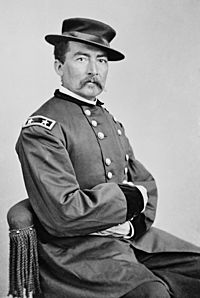
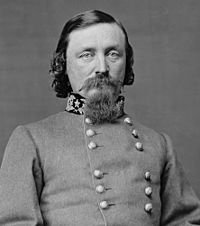
On March 31, Sheridan told Grant he could break the Confederate line if he had infantry help. He wanted a specific corps, but Grant said it was too far away.
Around 9:00 a.m., Union patrols scouted Confederate positions. They found Confederate cavalry and infantry moving towards Dinwiddie Court House. Pickett had decided to attack Sheridan despite the bad weather.
Union brigades were sent to guard different crossings of a swampy creek called Chamberlain's Bed. They faced west, expecting an attack from that direction.
Confederate Attacks at the Fords
Around 11:00 a.m., Fitzhugh Lee's cavalry attacked Fitzgerald's Ford. Union soldiers with repeating carbines fought back hard. The Confederates eventually forced their way across the creek.
Pickett then decided to cross at Danse's Ford, further north, with his infantry. He sent other brigades to cross at Fitzgerald's Ford.
Later in the afternoon, the Confederates attacked Fitzgerald's Ford again. They forced the Union soldiers to retreat.
Pickett Crosses Danse's Ford
Pickett's infantry brigades attacked Danse's Ford. Union soldiers guarding the ford were outnumbered and outflanked. They were forced to retreat.
Pickett then sent his other infantry brigades across the ford. Union forces tried to delay them, but the Confederates kept pushing forward.
Union Delays and Retreats
Confederate cavalry also attacked the Union lines. Union brigades were forced to retreat. Pickett's patrols moved through the woods, trying to separate Union forces.
Sheridan ordered some of his brigades to move to Dinwiddie Court House. The escape of these Union brigades was helped by other Union forces attacking Pickett's flank.
Holding the Line
Other Union brigades, led by Brigadier General Alfred Gibbs and Brigadier General John Irvin Gregg, held a line on Adams Road. They fought Pickett's advancing infantry for almost two hours. Eventually, they had to fall back.
Custer Arrives and Holds the Line

Sheridan called for two of Brigadier General George Armstrong Custer's brigades. Custer's men were fresh. They deployed about three-quarters of a mile north of Dinwiddie Court House.
As darkness approached, the Confederates attacked Custer's line. Custer's soldiers, using their repeating rifles, drove them back twice. On the left, Fitzhugh Lee's cavalry attacked, but the Union soldiers held out until they ran out of ammunition.
As it got dark, Custer led a charge that pushed the Confederates back. Pickett ordered his attack to end because of the darkness and Custer's strong resistance. The two armies were very close to each other at the end of the day.
Results of the Battle
The Battle of Dinwiddie Court House was a temporary Confederate victory. They pushed the Union cavalry back. But the Union cavalry, with their repeating carbines, fought hard. They slowed the Confederates all day.
The Confederates suffered more losses. They could not hold their advanced position. The Confederates lost about 760 soldiers. The Union lost 354.
Sheridan told Grant that Pickett's force was in more danger than his own. He believed they had drawn the Confederate infantry out of their defenses. This was a chance to attack them.
What Happened Next
Union V Corps Moves to Help
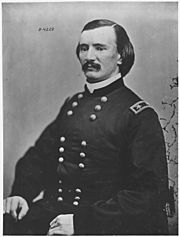
Even though Sheridan later criticized him, Major General Gouverneur K. Warren sent Brigadier General Joseph J. Bartlett's brigade to help Sheridan. Bartlett's men moved through the dark and engaged Confederate pickets.
Grant ordered Warren's entire V Corps to support Sheridan. But the roads were muddy, and a bridge was out. This caused delays. Grant mistakenly told Sheridan that Warren would arrive by midnight. This was impossible.
Through the night, Warren's soldiers marched. By dawn, one of Warren's divisions arrived near Sheridan's position.
Pickett Retreats to Five Forks
Pickett realized his position was not safe. He learned that Bartlett's brigade was coming to reinforce Sheridan. This meant his force could be trapped between Union infantry and cavalry.
So, Pickett withdrew his forces to Five Forks by 5:00 a.m. on April 1. This gave up any advantage he had gained. Pickett's retreat allowed him to defend Five Forks and the South Side Railroad.
Sheridan sent his cavalry to chase the retreating Confederates. But without infantry support, he did not push them too hard.
When the Confederates reached Five Forks, they started to improve their defenses. However, their defenses were not very strong.
Setting the Stage for Future Battles
The Union gains at White Oak Road and the movements of Warren's corps set the stage for major Union victories. The Confederates suffered a big defeat at the Battle of Five Forks on April 1, 1865. Then, the Union broke through the Confederate lines at the Third Battle of Petersburg on April 2, 1865.
These defeats forced the Confederates to leave Petersburg and Richmond. General Lee's army was chased by the Union Army. This chase led to Lee's surrender at the Battle of Appomattox Court House on April 9, 1865.
Images for kids


